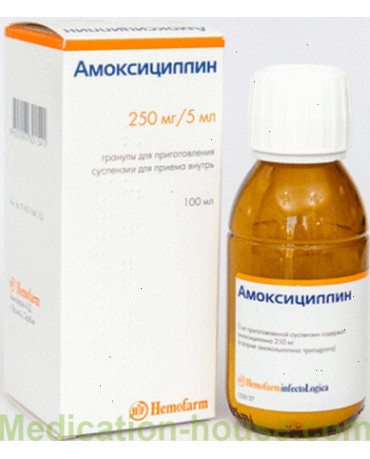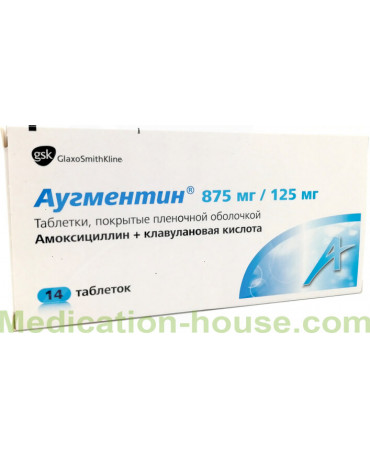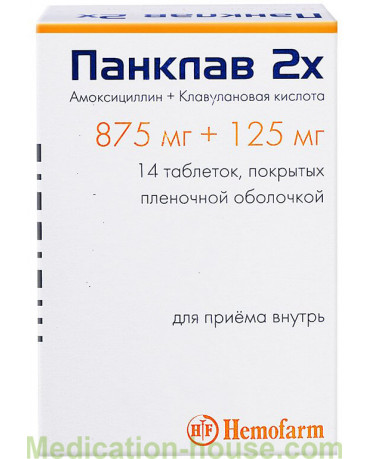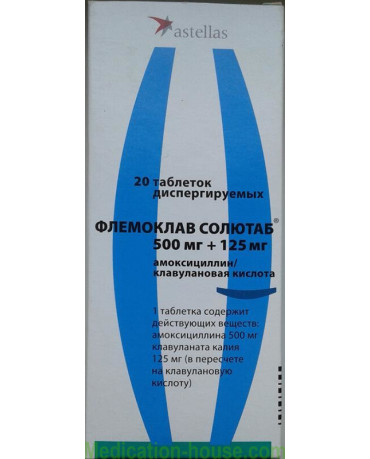Amoxicillin instruction
You can buy Amoxicillin here
Pharmacodynamics
Amoxicillin is antibacterial, bactericidal, acid-resistant, broad-spectrum agent from the group of semi-synthetic penicillins. Inhibits transpeptidase, violates peptide synthesis of peptidoglycan (cell wall supporting protein) during the period of division and growth, causes lysis of bacteria.
Active against aerobic gram-positive bacteria: Staphylococcus spp. (with the exception of strains producing penicillinase), Streptococcus spp. and aerobic gram-negative bacteria: Neisseria gonorrhoeae, Neisseria meningitidis, Escherichia coli, Shigella spp., Salmonella spp., Klebsiella spp. Microorganisms that produce penicillinase are resistant to the effects of amoxicillin.
Pharmacokinetics
Absorption of Amoxicillin - fast, high (about 93%), food intake does not affect absorption, does not collapse in the acidic environment of the stomach. When taken orally in a dose of 125 mg and 250 mg Cmax in the blood plasma is achieved in 1-2 hours and is 1.5-3 μg / ml and 3.5-5 μg / ml, respectively. It has a large Vd: found in high concentrations in plasma, sputum, bronchial secretions (weak distribution in purulent bronchial secretions), pleural and peritoneal fluids, urine, blister contents, lung tissue, intestinal mucosa, female genitals, prostate gland, fluids middle ear, bone, adipose tissue, gall bladder (with normal liver function), fetal tissues. With an increase in dose of 2 times the concentration also increases by 2 times. Concentration in bile exceeds concentration in plasma 2-4 times. In amniotic fluid and umbilical cord vessels, amoxicillin concentration is 25–30% of the plasma level of a pregnant woman. Poor penetrates the blood-brain barrier, with inflammation of the meninges (meningitis), the concentration in the cerebrospinal fluid is about 20%. Communication with plasma proteins is about 17%.
Partially metabolized to form inactive metabolites. T1 / 2 - 1-1.5 hours. It is eliminated by 50-70% by the kidneys unchanged by tubular secretion (80%) and glomerular filtration (20%), by the liver - 10-20%. In small quantities excreted in breast milk. T1 / 2 in premature babies, newborns and children up to 6 months - 3-4 hours. In case of impaired kidney function (creatinine clearance less than or equal to 15 ml / min) T1 / 2 increases to 8.5 hours. Amoxicillin is removed during hemodialysis.
indications
Bacterial infections caused by sensitive microflora:
infections of the respiratory tract and upper respiratory tract (sinusitis, pharyngitis, tonsillitis, acute otitis media; bronchitis, pneumonia);
infections of the genitourinary system (pyelonephritis, pyelitis, cystitis, urethritis, gonorrhea, endometritis, cervicitis);
gastrointestinal tract infections (peritonitis, enterocolitis, typhoid fever, cholangitis, cholecystitis);
infections of the skin and soft tissues (erysipelas, impetigo, secondarily infected dermatosis); leptospirosis;
listeriosis;
Lyme disease (borreliosis);
dysentery;
salmonellosis;
salmonello carrier;
- Meningitis;
- endocarditis (prophylaxis);
- sepsis.
Dosing
Inside, before or after meals.
Adults and children over 10 years of age (weighing more than 40 kg) are prescribed 500 mg of Amoxicillin 3 times / day; with severe infection - 0.75-1 g 3 times / day.
Children are prescribed in the form of a suspension: at the age of 5-10 years - 250 mg Amoxicillin (5 ml of suspension) 3 times / day; 2-5 years - 125 mg each (2.5 ml suspension) 3 times / day; under 2 years old - 20 mg / kg body weight per day, divided into 3 doses.
In preterm and newborns, the dose is reduced and / or the interval between doses is increased. The course of treatment is 5-12 days.
In acute uncomplicated gonorrhea, 3 g is administered once; When treating women, it is recommended to re-take the indicated dose.
For acute infectious diseases of the gastrointestinal tract (paratyphoid fever, typhoid fever) and biliary tract, for gynecological infectious diseases for adults - 1.5-2 g 3 times / day or 1-1.5 g 4 times / day.
With adult leptospirosis, 0.5–0.75 g 4 times / day for 6–12 days.
When adults are salmonelloson, 1.5–2 g 3 times / day for 2–4 weeks.
For the prevention of endocarditis in small surgical interventions for adults - 3-4 g 1 hour before the procedure. If necessary, appoint a repeated dose after 8-9 hours.
In children, the dose is reduced by 2 times.
In patients with impaired renal function with creatinine clearance of 15-40 ml / min, the interval between doses increases to 12 hours; with creatinine clearance below 10 ml / min, the dose is reduced by 15-50%; with anuria - the maximum dose of 2 g / day.
Side effects of Amoxicillin
Allergic reactions: possible urticaria, skin flushing, erythema, angioedema, rhinitis, conjunctivitis; rarely - fever, joint pain, eosinophilia, exfoliative dermatitis, polyformal exudative erythema, Stevens-Johnson syndrome; reactions similar to serum sickness; in rare cases, anaphylactic shock.
On the part of the digestive system: dysbacteriosis, change in taste, vomiting, nausea, diarrhea, stomatitis, glossitis, a moderate increase in the activity of hepatic transaminases, pseudomembranous enterocolitis.
Nervous system disorders: agitation, anxiety, insomnia, ataxia, confusion, behavior change, depression, peripheral neuropathy, headache, dizziness, convulsive reactions.
Laboratory indicators: leukopenia, neutropenia, thrombocytopenic purpura, anemia.
Others: shortness of breath, tachycardia, interstitial nephritis, vaginal candidiasis, superinfection (especially in patients with chronic diseases or low body resistance).
Contraindications for Amoxicillin
allergic diathesis;
bronchial asthma;
pollinosis;
Infectious mononucleosis;
lymphocytic leukemia;
liver failure;
a history of gastrointestinal diseases (especially colitis associated with the use of antibiotics);
lactation period;
hypersensitivity (including to other penicillins, cephalosporins, carbapenems).
With care - pregnancy, a renal failure, bleedings in the anamnesis.
During pregnancy and lactation
Be wary of using Amoxicillin during pregnancy. Contraindicated during lactation.
Interaction with other drugs
Pharmaceutically incompatible with aminoglycosides (to avoid mutual inactivation, do not mix).
Antacids, glucosamine, laxatives, food, aminoglycosides slow down and reduce absorption; ascorbic acid increases absorption.
Bactericidal antibiotics (including aminoglycosides, cephalosporins, cycloserine, vancomycin, rifampicin) - synergistic effect; bacteriostatic drugs (macrolides, chloramphenicol, linkosamides, tetracyclines, sulfonamides) are antagonistic.
Increases the effectiveness of indirect anticoagulants (suppressing the intestinal microflora, reduces the synthesis of vitamin K and prothrombin index); reduces the effectiveness of estrogen-containing oral contraceptives, drugs, in the process of metabolism of which paroaminobenzoic acid is formed, ethinyl estradiol - the risk of breakthrough bleeding.
Diuretics, allopurinol, oxyphenbutazone, phenylbutazone, NSAIDs, drugs that block canalicular secretion, reduce tubular secretion, increase concentration.
Allopurinol increases the risk of skin rash.
Decreases clearance and increases the toxicity of methotrexate.
Strengthens digoxin absorption.
Overdose with Amoxicillin
Symptoms: nausea, vomiting, diarrhea, disruption of water and electrolyte balance (as a result of vomiting and diarrhea).
Treatment: gastric lavage, activated carbon, saline laxatives, drugs to maintain water and electrolyte balance; hemodialysis.
Release form
Capsules, 250 or 500 mg - 10, 16 or 20 pcs.
Storage conditions
To store in the unavailable to children, dry, protected from light place at a temperature from 15 ° to 25 ° C.
Shelf life - 3 years.
Composition
1 capsule:
Amoxicillin (in the form of trihydrate) - 250 or 500 mg
Excipients: magnesium stearate, microcrystalline cellulose PH 102
Terms of sell
The prescription is not required to buy Amoxicillin.






